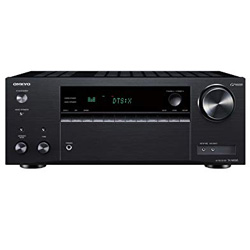 Onkyo has opened the new season of 2018 with the release of the next version of its classic 600-series receiver. The novelty replaced the TX-NR676 and differs from the previous model in advanced functionality. Check out Onkyo TX-NR686 specs in this Onkyo TX-NR686 review.
Onkyo has opened the new season of 2018 with the release of the next version of its classic 600-series receiver. The novelty replaced the TX-NR676 and differs from the previous model in advanced functionality. Check out Onkyo TX-NR686 specs in this Onkyo TX-NR686 review.
Onkyo TX-NR686 review
Features
In addition to the main 7.2 channels - the last two of which can be used both for the rear and for the speakers of the “upper” channels in the Dolby Atmos or DTS setup: X - TX-NR686 is equipped with additional amplification channels for connecting a pair of speakers in the second zone. And given the receiver's output power, which is 165 watts per channel (6 ohm), even with fairly demanding acoustics, it should not have any problems.
Design and build
The TX-NR686 outperforms most of its competitors and, given the built-in 384 kHz / 32-bit DAC, saves a little while organizing a stereo system in another room. The Onkyo TX-NR686 is THX Select certified, reflecting its superior cinema performance. To obtain the most dynamic and rich sound while maintaining the comparatively compact dimensions of the case, this seven-channel AV receiver is equipped with amplifiers made using Dynamic Audio Amplification technology. Due to the high output current, which is provided including through the use of a custom transformer H.C.P.S. in the power supply, Onkyo TX-NR686 is able to fully swing even 4-ohm speakers. The audio circuit of the device also uses the VLCS system to eliminate high-frequency noise, and its circuitry eliminates the phase shift of the signal to maintain sound transparency.

Connectivity
The device has a good set of physical inputs, it has seven HDMI connectors with HDCP 2.2 support (one of which is located under the volume control on the front panel), two optical and one coaxial digital inputs, a USB port, six analog inputs (including 3.5 mm front panel jack) and MM Phono input for connecting a turntable.
Setup
The AccuEQ auto-tuning system takes into account the location and type of speakers mounted on the ceiling using the AccuReflex function. If instead of ceiling speakers models based on reflections and installed in the frontal plane are used, the system will take this into account and adjust the signal phase accordingly.
Pros and Cons
Pros
- In fact, the device is really worthwhile, it has a good set of functions and is easy to listen to all day long
- Decent level of detail
Cons
- Not enough drive and speakers when playing
Common features
Product
Model
Brand
Reviews
Amplifier
Channels
Stereo power (RMS), W/Ohm
Output impedance, Ohm
Frequency response
THD in stereo, %
Audio features
Digital to analog converter (DAC)
Bi-amping
Pure direct (straight)
Auto speaker calibration
Speaker A/B switching
Other audio features
Connectivity
Wi-Fi
USB
Bluetooth
Ethernet (RJ45)
DLNA
MHL
Streaming services
Apple Music (AirPlay)
Amazon Music
Spotify
Other streaming services
Extensive connection
HDMI input/output
HDMI ARC (Audio Return Channel)
HDMI eARC (Enhanced Audio Return Channel)
HDMI CEC
Digital content protection (HDCP)
Subwoofer output (LFE)
Headphone output
Optical digital input
Coaxial digital input
Composite input
Component input/output
Phono (MM) input
Front panel connectors
Multi channel preamp output
Video features
HDR (High Dynamic Range)
4K signal pass-through
8K signal pass-through
HDMI signal pass-through
3D signal pass-through
HDMI pass-through in standby mode
Video conversion
Analog to HDMI scaling
HDMI to HDMI scaling
Dolby Vision
Other video features
Additional features
Voice control
App control
Display
Tuner
Sleep timer
Auto power off
ECO mode
Graphical user interface (GUI)
Setup assistant
Firmware update
Other additional features
Multi-room
Multi-room zones
Zone audio output
Zone HDMI output
Multi-room control
RS-232
Remote control input/output (IR)
DC trigger output (12V)
Multichannel surround
Dolby Atmos
Dolby TrueHD
Dolby Surround
Dolby (other)
DTS:X
DTS HD Master
DTS Virtual:X
DTS Neural:X
DTS (other)
Auro-3D
IMAX Enhanced
Multichannel stereo
Audio file formats
MP3
WMA
AAC
WAV
FLAC
ALAC
Other audio file formats
Power
Operational power consumption, W
Standby consumption, W
Removable power cord
User manual
Manual
Dimensions
Size W x H x D, cm/inches
Weight, kg/lbs
Other
Release year












